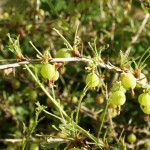- Gooseberry bushes at Great Lakes Permaculture 2014
- Gooseberry sawfly caterpillar
I am behind on my usual duties in the garden, no excuses except I started late this year, the weather did not help, and I always try to accomplish more than I can possibly get done by myself. The last few weeks, I have been happily moving through the garden cutting weeds, staking a plant here or there, performing usual maintenance on the garden. The north side of the house always gets neglected, that is part of the design so I do not have to worry about those plants and bushes as they are basically self-sustaining, a combination of Jostaberrys, Currants, and Gooseberry’s.
So when I finally did pay a little attention to the forgotten little things, I was upset with myself to find out that something has been eating away at my Gooseberry’s. Not the entire plant, just about every single leaf on the plant, leaving only the naked stems of the leaf similar to the eerie trees sticking up in the moonlight in a cheesy horror movie. The Gooseberry’s looked fine for now, but I knew that they would not survive long without the nourishment that the leaves provide, I could lose my entire crop in a matter of a few short days. I had to act fast, I could “Ask a Master Gardener”, or I could set out on my own to find this sinister fiend.
Gooseberries are not a common fruit crop in the area, a minor fruit that is a member of the Ribes family. Although the Gooseberry is indigenous to many parts of Europe and western, south and Southeast Asia, my memories of the Gooseberry revolve around the British countryside, provided in novels dating back to William Turner, the naturalist in his notes around the middle of the 16th century. He noted that the common pests are the magpie moth (Abraxas grossulariata) caterpillar, (Macaria wauaria) and Gooseberry sawfly (Nematus ribesii). Many of the early varieties of Gooseberry’s are susceptible to white pine blister rust, but that is not the problem that I am experiencing. Checking the previous mentioned pests, the Gooseberry sawfly was a perfect match for what I saw growing in front of me. The details of the pest are show immediately below. The documents also show that this pest will attack Currants, the sawfly had not gotten to my Currants which are next to the Gooseberry’s and I did not want them to get there.
Severe defoliation of the bushes can be caused by the caterpillar-like larvae of one of three species of sawfly.
Larvae of the common gooseberry sawfly are up to 20mm (almost 3/4in) long, pale green, with many black spots, and black heads The adult females are 5-7mm (up to 1/4in) long and are yellow with black heads and black markings on the thorax; males are similar but more extensively marked with black, including the upper surface of the abdomen.
Larvae of the pale spotted gooseberry sawfly are smaller than those of the common gooseberry sawfly and have pale green heads.
The small gooseberry sawfly can have up to four generations of pale green larvae from late April on-wards. The larvae of some moths may also eat the foliage of gooseberries and currants.
Methods of treatment include picking them off by hand, not an option I plan to execute. Chemicals are available, but my first choice is always an organic option if I have one. My course of action is to place Diatomaceous earth around the base of the plant to try and catch them before they drop to the soil and form a cocoon from which the next generation emerges, there may be three or four of these a year. I also used an application of Neem oil spray which will cause the sawfly to drop from the bush so they can be easily gathered and disposed of. Round one for the sawfly, but round two went to me, round three and all future rounds are within my control. Thank you to William Turner.


